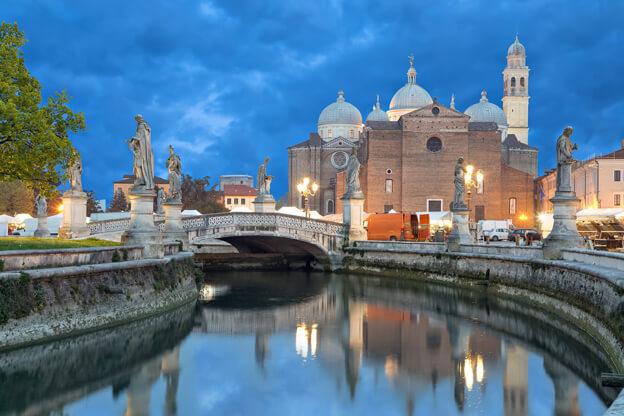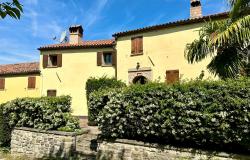Less than a 30-minute ride on the high-speed train from Venice, Padua is too often disregarded from the majority of visitors. Yet, it makes for a great day trip from Venice, offering a glimpse into the rich history of a city that once was a powerful Comune.
Home to Italy’s second oldest university, founded in 1222, Padua has retained the vivacious atmosphere of a university town, with lively piazzas and arcaded streets, plenty of cafés and bars where the ubiquitous Spritz is de rigueur as the day winds into evening.
If you’re in town for just one day, here are the five things you shouldn’t miss.
Basilica di Sant'Antonio

While not the city’s cathedral, the Basilica of Saint Anthony is Padua’s most revered religious site, as it houses the tomb of Saint Anthony, patron saint of the city. In fact, it’s a much visited pilgrimage site, and you’ll see people crowding around the Cappella del Santo, where the saint is buried.
The architecture of the building is a mix of different styles, from Romanesque to Byzantine (obvious in the domes, similar to those of St. Mark’s) to Gothic (the façade). Construction began in 1232, one year after the death of Saint Anthony, and was completed in 1310, but the building underwent several modifications during the Renaissance.
Inside, there are a number of notable funerary monuments and frescoes. The relics of St. Anthony are kept in the baroque Treasury Chapel behind the high altar. Here, you’ll also find magnificent reliefs by Renaissance master Donatello. The Chapel of the Holy Sacrament houses the tomb of the famous Renaissance condottiero Gattamelata.
Make sure you peek into the Chiostro della Magnolia, in the attached monastery, to admire the majestic magnolia tree rising in the grassy center.
Also, in front of the Basilica, is Donatello's magnificent equestrian statue of the Venetian general Gattamelata. Made in 1453, it was the first full-size equestrian bronze cast since antiquity, inspired by the equestrian sculpture of Marcus Aurelius found at the Capitoline Hill in Rome.
Prato della Valle

Prato della Valle is one of Padua’s landmarks, a 90,000-square-meter elliptical square, the biggest in Italy and one of the largest in Europe. Located at the southern edge of the historical center, it’s a favorite gathering spot for the locals, who call it ‘il Prato’.
Always a focal center of the city’s social and economic life, with markets, fairs, festivals, performances and races taking place in the area since Roman times, it was even a favorite spot for Saint Anthony to preach his sermons.
The square is a big monumental space with a green area, called Isola Memmia from the podestà who commissioned the work, in the center. It’s surrounded by a canal decorated with 78 statues of famous Paduan figures from the past.
In the summer, you’ll find plenty of Padovani walking and basking in the sun, and university students studying during the day and chatting the evening away at night.
Scrovegni Chapel

Giotto’s cycle of frescoes inside the Scrovegni Chapel is considered one of the most important masterpieces of Western art.
Commissioned to the Tuscan artist by the affluent Paduan banker Enrico Scrovegni in the early 1300s, the frescoes depict the lives of the Virgin Mary and Christ in a way that parts from previous and contemporary art. The figures are no longer elongated or stylized as in the Byzantine style, they wear clothes that hang naturally, they are three-dimensional – in other words, they appear ‘real’. Giotto also made use of perspective, which was not common at the time.
The Scrovegni Chapel is located in Piazza Eremitani, a short walk from the train station. Advance reservation is mandatory and can be made on the Scrovegni Chapel website.
Palazzo del Bo and Anatomical Theater

The university has always been a major fixture of Padua. Boasting among its teachers Galileo, Copernicus, and the world’s first female doctor of philosophy, Eleonora Lucrezia Cornaro Piscopia, it’s been housed, since 1539, in the Bo Palace, which can be visited exclusively through a 45-minute guided tour.
The University of Padua was founded following an ‘exodus’ of teachers and students from the University of Bologna, looking for greater freedom.
The building developed around the famous ‘Cortile Antico’ (Old Courtyard), a loggia on two floors with a double row of columns.
One of the most striking aspects of Palazzo del Bo is the large number of coats of arms, paintings and reliefs that decorate the entrance hall, the arcades, and many classrooms, including the Aula Magna.
The impressive Anatomical Theater, the oldest permanent structure for anatomy studies in the world, was built in 1594 and is still perfectly preserved. The dissecting table is surrounded by six rounds of carved walnut boxes. A stop in the Anatomical Theater is included in the guided visit.
Caffé Pedrocchi

Another Padua’s landmark, Caffé Pedrocchi is so important in the history of the city, and of the country, because it was a major gathering point for patriots during the 1848 riots against the Habsburg monarchy. On February 8, 1848, the injuring inside the café of a university student led to the first uprisings that would later be part of the Italian Risorgimento.
Caffé Pedrocchi was also a favorite haunt of intellectuals, artists and writers. Between the 18th and 19th centuries, coffee consumption spread to Italy and people started gathering in cafés rather than in the private spaces of the bourgeoisie’s living rooms. In Padua, the presence of students, professors and businesspeople encouraged the development of cafés as social venues.
Sit inside one of its rooms and imagine the cultural and political buzz that distinguished Caffé Pedrocchi since its opening in 1841.









